Galaxy Trail
1) Milky Way
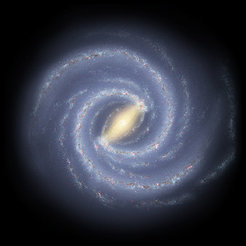
The starting point of the Galaxy Trail is our Milky Way. Our home galaxy consists of far more than a 100 billion stars, forming a flat spiral of 100,000 light years in diameter.
From here it takes 12.85 billion light years (scaled: 2,570 m) to the final destination at the edge of the known Universe. At normal walking speed (3 km/h – because of a bit of ascent on the walk) it takes a bit less than an hour, walking at 100 trillion times the speed of light in scale.
2) Andromeda Galaxy M 31
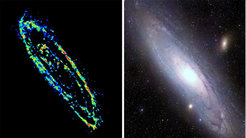
The Andromeda-Galaxie (M 31) is our next large-scale neighbour, a galaxy even larger and more massive than the Milky Way. At a clear night sky, far away from the city lights it might be visible to the unaided eye.
From the start we have walked 2.5 million light years (or 50 cm) and it takes another 12.85 billion light years (2570 m) to the final destination.
3) Starburst Galaxy M 82
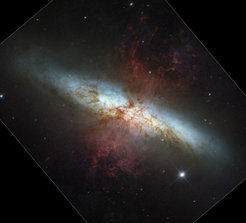
The Starburst Galaxy M 82 (NGC 3034) in the constellation Ursa Major (the great bear) is interacting with its large-scale neighbouring galaxy M81 and thus showing a strong burst of star formation in its central area.
From the start we have walked 12 million light years (or 2.4 m) and it takes another 12.84 billion light years (2568 m) to the final destination.
4) Active Galaxy M 87
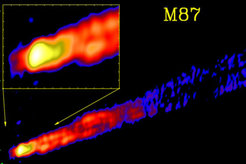
The active galaxy M87 (also NGC 4486, or Virgo A) is the central galaxy of a large cluster of galaxies, the Virgo cluster in the direction of the constellation Virgo (the virgin). M87 is a giant elliptical galaxy, 10 times more massive than the Milky Way, with a central black hole of several billion solar masses.
From the start we have walked 50 million light years (or 10 m) and it takes another 12.8 billion light years (2560 m) to the final destination.
5) Active Galaxy NGC 1275
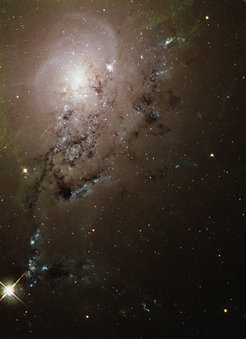
The active galaxy NGC 1275 (also Perseus A or 3C 84) is the central object of another cluster of galaxies, the Perseus cluster in the direction of the constellation Perseus (the Greek mythological hero). It is 100 times further away than the Andromeda galaxy.
From the start we have walked 250 million light years (or 50 m) and it takes another 12.6 billion light years (2520 m) to the final destination.
6) Cygnus A
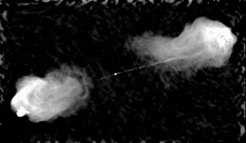
The radio galaxy Cygnus A (3C 405) is one of the strongest radio sources in the sky. It is in the direction of the constellation Cygnus (the swan). Radio images at higher resolution show a central nucleus with two energetic jets blowing out two radio lobes.
From the start we have walked 750 million light years (or 150 m) and it takes another 12.1 billion light years (2420 m) to the final destination.
7) Quasar 3C 273
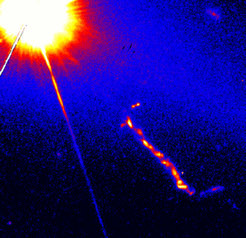
The quasar 3C 273 lies in the direction of the constellation Virgo (the virgin) and is the brightest “quasi-stellar source" or quasar in the sky. With an apparent magnitude of 13 it is as bright as the dwarf planet Pluto, but much more distant. Its total brightness is 300 times that of our Milky Way.
From the start we have walked 2.2 billion light years (or 450 m) and it takes another 10.65 billion light years (2120 m) to the final destination.
8) Quasar 3C 48
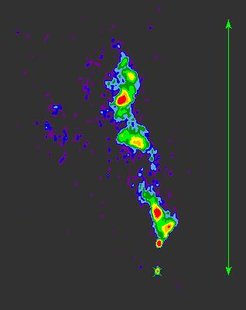
3C 48 in the direction of the constellation Triangulum (the triangle) is also a quasar. It is actually the first observed quasar, identified in the year 1960. The redshift of its spectral lines is 0.367, corresponding to a light travel time of almost four billion years.
From the start we have walked 4.0 billion light years (or 800 m) and it takes another 8.85 billion light years (1770 m) to the final destination.
9) Quasar 3C 295
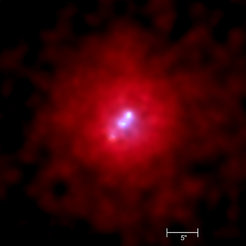
3C 295, in the direction of the constellation Boötes (the herdsman) is also a quasar, a radio galaxy with an extraordinarily bright nucleus. The source is regularly used as a calibration source for observations with the Effelsberg radio telescope in order to gauge the position accuracy (pointing) as well as the signal strength (flux calibration).
From the start we have walked 4.75 billion light years (or 950 m) and it takes another 8.1 billion light years (1620 m) to the final destination.
10) B0218+367
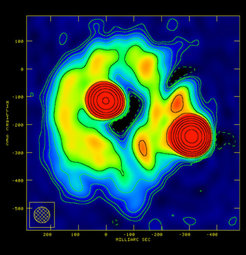
For galaxy B0218+367 in the direction of the constellation Triangulum (the triangle) it was possible to proof that a fundamental constant, namely the proton-electron mass ratio, is valid not only in the local but also in the distant universe.
From the start we have walked 6 billion light years (or 1200 m) and it takes another 6.85 billion light years (1370 m) to the final destination.
11) Quasar 3C 286
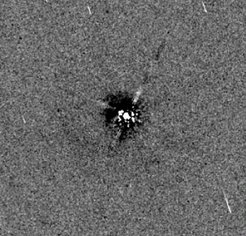
The quasar 3C 286 is observed in the direction of the constellation Canes Venatici (the hunting dogs). It is one of the most important calibration sources for radio observations with the Effelsberg 100 m radio telescope.
From the start we have walked 7.1 billion light years (or 1420 m) and it takes another 5.75 billion light years (1150 m) to the final destination.
12) 0917+62

The radio source 0917+62 is in the direction of the constellation Ursa Major (the great bear). The source is the nucleus of a distant radio galaxy. Brightness fluctuations on a very short time scale (so-called “Intraday Variability“ or IDV) were detected with the Effelsberg radio telescope.
From the start we have walked 9.2 billion light years (or 1840 m) and it takes another 3.65 billion light years (730 m) to the final destination.
13) MG J0414+0534
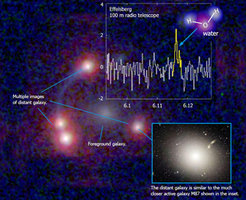
In 2008, the water molecule (H2O) was detected with the Effelsberg 100 m radio telescope in the galaxy MG J0414+0534 in the direction of the constellation Taurus (the bull) in a record distance of more than 11 billion light years.
From the start we have walked 11.3 billion light years (or 2260 m) and it takes another 1.55 billion light years (310 m) to the final destination.
14) J1148+5251
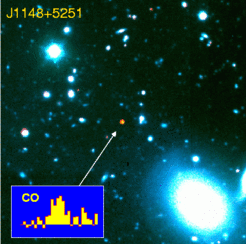
With the galaxy J1148+5251 in the direction of the constellation Ursa Major (the great bear) we have reached the last target of our Galaxy Trail. The radio signal takes almost 13 billion years in order to reach the Earth and it is still possible to trace gas and dust in this distant galaxy.
From the start we have walked 12.85 billion light years (or 2570 m) and (almost) reached our final destination. After another 950 million light years (or only 200 m) we would be coming back to the Big Bang and the beginning of our Universe. That position is marked by the Martinshütte (the “hut at the edge of the Universe”).













